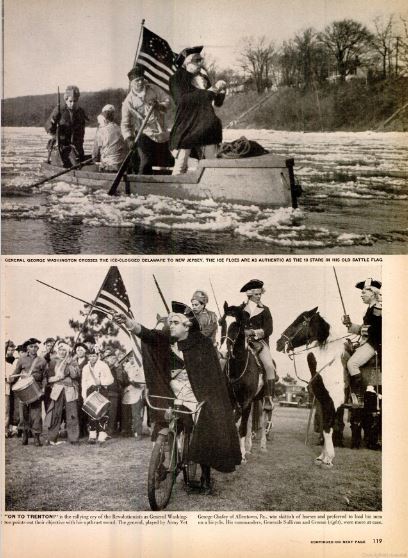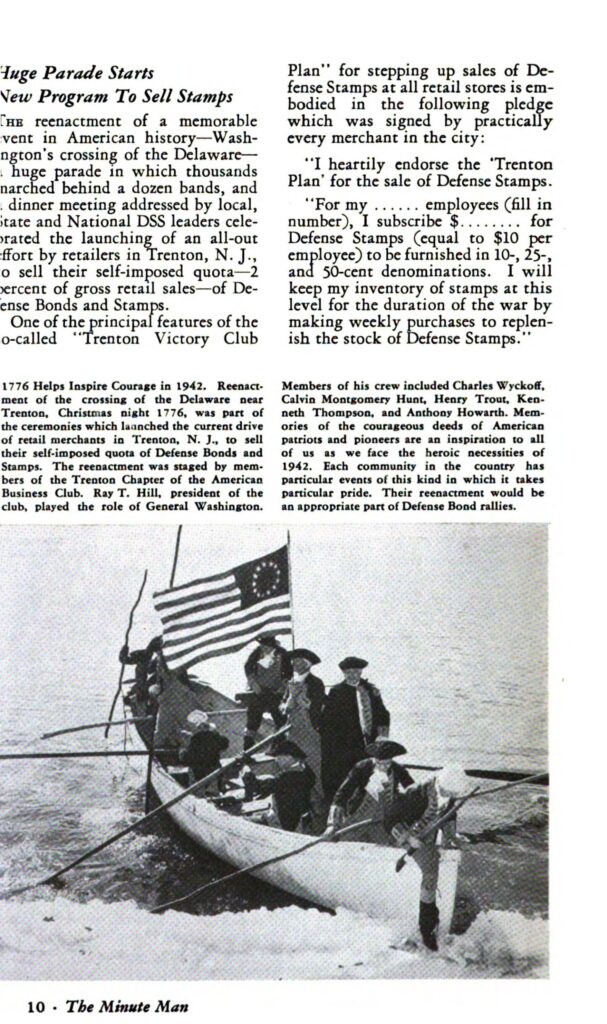The verdict is still out in identifying the first commemorative reenactment of Washington Crossing the Delaware. I am talking about ad hoc reenactments that occurred prior to annual theatrical presentations, which began in 1953. This year’s reenactment will be number seventy-one, and counting. According to a 2019 article written by Jonathan Wilson, the first attempted reenactment was in 1844 with a rowdy crowd and drunken participants but, unfortunately, no other details were provided.

Earlier reenactments held in 1931 and 1947 have been mentioned on the Washington Crossing Historic Park website. Here is a snippet from the May 24, 1931 issue of the Pittsburgh Press showing a staging of the Crossing performed by active military personnel, specifically the Army Engineers. It was a demonstration of the “modern way” of fording a river. The Army Engineers used aluminum pontoons propelled by outboard motors. Then there was the Rider College Fraternity Reenactment featured in the February 17, 1947 issue of Life Magazine below, which was more of a college prank.

A search of the internet found a Treasury Department Newsletter, The Minute Man, dated May 15, 1942 in which the members of the Trenton Chapter of the American Business Club staged Washington’s Crossing the Delaware to help sell Defense Bonds and Stamps. There is no date given for the day of the event. The War Bond Campaign was launched April 23rd of that year, but there appears to be snow on the ground in the photograph indicating a crossing at an earlier date. Unless…is it fake snow?
A short survey of existing articles indicates there were other reenactments and that this is an area ripe for further study and collection of source materials. We need not limit the search to just crossing events, but can expand to identify the number of “sham battles” held to commemorate Trenton and Princeton. I am not accustomed to handing out homework assignments, but I will make an exception on this subject. At the end of the day, it does not matter which is the “first”- we are, after all, having some fun here. However, you would suspect, without any research at all, that some type of reenactment would have at least occurred at the 1876 Centennial. I don’t think you would be off-base by suspecting an event every twenty-five years after 1776. This will require a lot of trolling through old newspapers. The best dates to start would be December 25 to 29 of each year, however, as has been learned, staged events of the crossing have occurred at different times of the year. It is not only the dates that matter, but you have the problem of whether the editor of the selected newspaper thought the event was newsworthy enough to write about it. For the time being, it would be interesting to find out just how many crossing events occurred before 1953. You can already start to see they will fall into different types or categories.

As it turns out, there was a reenactment of the crossing of the Delaware in 1876 as reported in the New York Herald, on Wednesday December 27, 1876 (p.3 of 10). It is also reported that this event was not part of the Centennial Exhibition in Philadelphia, but more of a local affair, and only part of an event more focused on commemorating the Battles of Trenton and Princeton. The clothing worn was of 1876 style and percussion cap rifled muskets, rather than flintlocks, were the equipment of the day.
The following is an excerpt from the New York Herald article which describes the 1876 Crossing. This was truly a remarkable and memorable event as Mother Nature forced the reenactors to forgo the boats and walk across the ice! Does any of this sound familiar?
“ The Centennial Celebration of the crossing of the Delaware by General Washington and the battle of Trenton came off to-day quite successfully. The programme, which included a sham battle, was carried out with commendable promptitude and precision, and the people of Trenton are naturally much elated over the events of last night and today.
The Crossing.
Sixteen gallons of whiskey had preceded the noble army of Washington to Taylorsville, or Washington’s Crossing. This was the number generally stated, but it may have been more or less. It was about half- past one in this morning when the company arrived at Mc Conkey’s Ferry, being all pretty well exhausted by their march from Trenton over the slippery snow-bound road. They stopped at Wollery’s wheelwright shop, and after having thoroughly refreshed their weary bodies they crossed over the bridge, thence to cross back over the river in the best style of Washington and to march on to Trenton… The men were somewhat tired with their long march from Trenton through a drizzling storm and over frozen roads, but they plucked their courage and bravely shouldered their muskets and moved down to the river’s edge.
The night was dark, cloudy and intensely cold. A light fall of snow drizzled into the men’s faces and impeded their progress. The original idea was to cross in boats and imitate as nearly as possible Washington’s achievement, but this was found to be impossible, the river was firmly frozen over from bank-to-bank. There was nothing for it but to pass afoot, and this courageously undertaken amid the encouraging cheers of the inhabitants of Taylorsville and its vicinity, who chose, however, the more prosaic passage by the bridge themselves.
An incident worth noting that added to the drama of the evening is that a descendant of the man who acted as the guide for General George Washington failed to show up to lead the reenactors across the ice. A “saviour” appeared. A local resident “ with the soul of a hero”. Henry Hill, an African American, who armed himself with an axe, and sounded the ice in order to discover a safe passage. It was a zig-zag course. Mr. Hill put down his axe, picked up a lamp, and followed by two other volunteers with lamps, led the men over the frozen river. “ The waving of the lamps by the guides and the slow moving of the dark silent line was peculiarly ghostlike…”
For the 1876 event, General Treux portrayed General Washington. According to a 2021 article written by Mark Maloy, this was General William Snyder Truex, who commanded a brigade of Union soldiers during the 1864 Battle of Monocacy. All combined, about 1,200 men, which included Civil War veterans, participated in either the crossing of the Delaware, the march to Trenton, and the battle of Trenton. Many local militias and national guard units formed the groups portraying the Continentals and Hessians.
For further background information see “Hundreds reenact George Washington’s daring Christmas Day Delaware River crossing” by Johnathan Wilson, December 25, 2019; and “When Civil War Veterans Reenacted the Battle of Trenton and Princeton” by Mark Maloy, December 8, 2021.
Denis J. Cooke is an independent researcher, a retired lawyer and CPA, and a member of the 5th Pennsylvania Regiment since 1997. He is a long time volunteer and member of the Friends of Washington Crossing Park.

